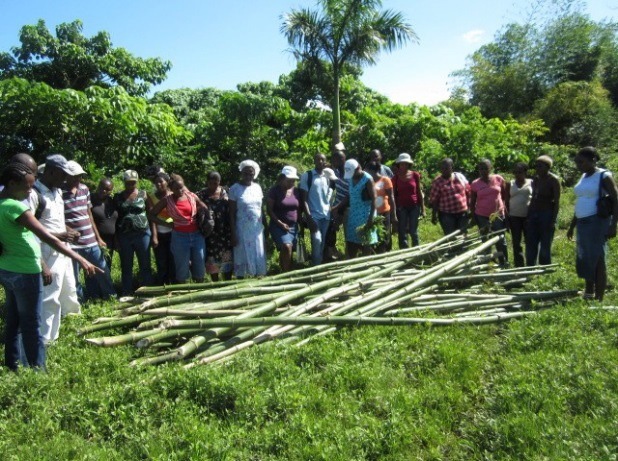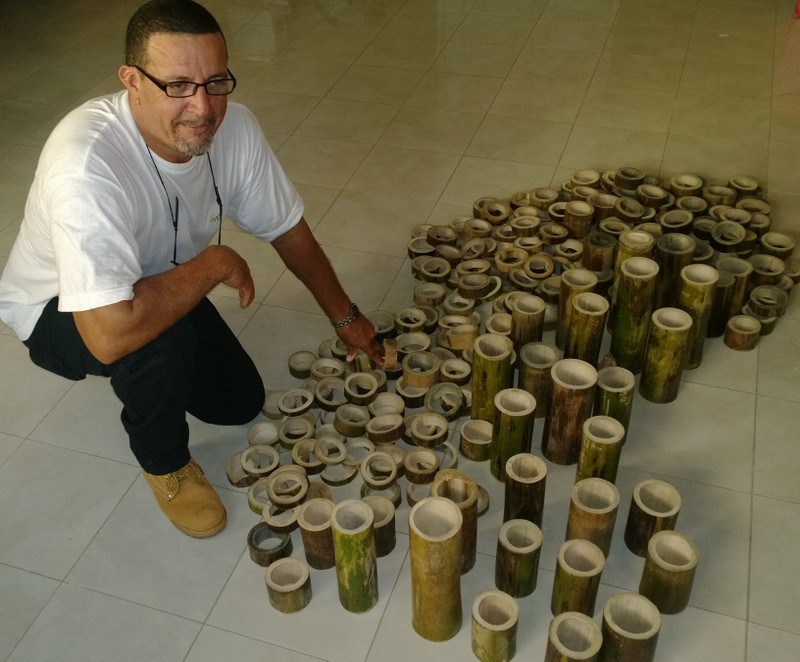Artisans Helping Themselves to Help Haiti
November 22, 2013
CAP HAITIEN, HAITI – During Week 3 of the training workshop, Vonley Greaves, the bamboo expert from St. Vincent and the Grenadines, took the artisans on a field trip to a nearby bamboo growing region. They learned about the plant in its natural habitat, its growth habits, properties, and its great possibilities not only as a raw material for bamboo jewelry but also as part of a potential remedy for Haiti’s threatened environment.

Over the past several years of creating beautiful products from bamboo, Vonley has developed a deep understanding of this raw material. He believes that artisans wishing to make a living from bamboo will achieve the best results if they learn about bamboo, respect it and use it carefully and responsibly. Below are Vonley’s recommendations for caring for the bamboo while using the healthiest pieces to make the bangles.

Cutting
The process involved in making a bamboo bangle starts with cutting a bamboo pole.
Each pole needs to be cut with either a chain saw or a hand saw, one at a time. At present, cutlasses (machetes) are being used. The slashing with a cutlass results in the loss of poles on either side of the ones targeted. Many of these poles are too small to use or sell. They are left on the ground in the grove rather than continuing to grow into usable pieces. They also cover the ground discouraging the growth of new sprouts.
Replanting
For each pole cut, Vonley suggests removing at least two sprouts from the pole and replanting them in the grove right after harvesting.
Tending the grove
The grove must be cleaned from fallen debris after cutting. After the new little shoots are planted, they need to be covered with the fallen bamboo leaves that will provide protection. These practices will leave the bamboo groves invigorated, renewed and allow the bamboo to be harvested indefinitely in a healthy, sustainable manner.
Specific timing for harvesting
For bamboo to be healthy and bug free it must be harvested only at certain times of the lunar cycle: three days before and three days after the new moon (the darkest period). In a little-known symbiotic relationship, “bamboo bugs” live and feed on the bamboo. When left undisturbed, they eat only unhealthy bamboo, a process essential to the healthy growth of the bamboo grove. If the bamboo is cut at other times, bugs will attack the bottom of the cut pieces treating them as if they are damaged. This can threaten the entire grove. When people understand and respect the timing of the cutting they will be rewarded with bamboo that is healthy and free from bugs. (These bugs know!)



Non-toxic, environmentally friendly materials
Vonley uses only non-toxic, water-based materials during the production of the bamboo bangles including all paints and finishes.
Bamboo grove destruction, soil erosion and more
When traveling the environs of Cap Haitien, Vonley spotted several areas where bamboo has been harvested improperly. Street vendors seem to haphazardly cut entire bamboo groves with a cutlass without realizing the harm they are causing. Entire groves are being destroyed. Most of the harvested bamboo is also cut when too young which can also result in the destruction of the grove or will cause it to grow back slowly and unhealthily. In addition to harming the bamboo, these practices are direct causes of soil erosion – a huge loss of valuable farmland, a significant problem in Haiti. And not just on the land: During heavy downpours, with no roots to hold the soil in place, the soil washes directly into the ocean with devastating results to undersea animals and birds. In addition, the majority of the bamboo sold by street vendors is infested with bugs – unknowingly cut at the wrong time. And much of this bamboo is used for construction –
in an area with a history of earthquakes.
Vonley saw no evidence of replanting the bamboo. He says that careful planting of new bamboo in areas with significant soil erosion could dramatically alter this trend throughout the country.

Bamboo bangles created by the artisans during Week 3. Their sense of color, ease and confidence with patterns and the tools is amazing. A selection of these bangles and new ones to come will be selected and shown to small tourist stores in Cap Haitien. Sales people will be asked to relate customer reactions to the artisans. Profits from sales will be re-invested into raw materials.






